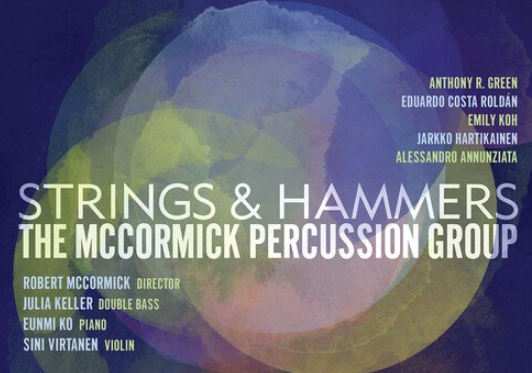CD Review: “Strings & Hammers”
The McCormick Percussion Group
Robert McCormick, director
Julia Keller, double bass; Eunmi Ko, piano; Sini Virtanen, violin
Ravello Records
Catalog #: RR8037
A very stimulating recent arrival across my pandemic-starved desk was Strings & Hammers, a CD of contemporary music with strong social consciousness themes underlying each work. Of course, the critic’s job is to state if the music works “as music” without reference to the declared program. I am happy to report that this recording does so amply.
The very resourceful pianist Eunmi Ko had the initial idea for this suite of works. She is a member of the unusual piano trio “Strings & Hammers” (piano, violin, double bass), though I have heard her shine in more traditional repertoire (Eunmi Ko in Review ). She is a well-known champion of contemporary and under-programmed music, to which her virtuosity adds the excitement that may just get people interested in it.
Ms. Ko bravely dares to do what generations of piano teachers have insistently tried to eradicate from their students: recognize the essential percussive nature of the instrument. Of course, hammers do rise and strike strings, and sound immediately begins to decay—this is just physical fact. Any “singing tone” we impart to the piano is caused by mastering aural illusions through creative use of the pedal and gentle transmission of energy from the fingers, combined with the listener’s willingness to sustain tone in the mind. Ms. Ko’s repertoire of colors prevents her from sounding harsh however, and with the wide variety of repertoire on this disc, the ear never tires.
The opening work is Anthony R. Green’s Piano Concerto: Solution, commissioned by Ms. Ko and Mr. McCormick. The two movement titles, Tension and Solution, are a clever play on the harmony terms tension and resolution. Tension opens with three and a half minutes of kinetic energy and a piano solo that, due to Mr. Green’s compositional skill and Ms. Ko’s playing, makes the soloist sound like she has at least three hands, so instantaneous are her shifts from both extremes of the keyboard to whirring material in the middle register. Had Debussy lived another hundred years, I imagine Mouvement from Images, premier livre could have sounded like this. At this three-and-a half minute mark, clapping, footwork, brushing, and eventually vocalizations begin to cooperate and contrast with the piano part in rhythmically complicated patterns that gradually subside to the end of the movement. The second movement, Solution, begins shrouded in darkness and mystery in the piano, though it does “wake up” about three minutes in. Perhaps solutions are not easily gained. The sonorities are hauntingly beautiful.
Eduardo Costa Roldán’s Pulsar thrives marvelously on the extremes of sonority that are obtainable when piano, violin, double-bass, and percussion combine. The shifting rhythmic patterns, cleverly united through a constant pulse, provide maximum interest. The work builds to a climax and then seems to vanish into cold, interstellar space.
Memento Mori (a reminder of one’s mortality) by Emily Koh begins with ominous rumblings in the percussion, followed by the lowest notes of the double-bass, which is cleverly combined with the violin to create one “super” instrument. This seems to open up a cavernous tomb-space into which have fallen: humanity, civility, morals, courage, empathy, compassion, logic, common sense, and backbone (according to the composer). The work ends with the highest whistle-tone harmonics the violin can provide. Is it a message of angelic hope? Whether this work succeeds as a “charge for those who still stand righteous and strong to fight back and never back down” is for each listener to determine. Ms. Koh calls this work a surreptitious “concerto for superbass and percussion.”
Ice Concerto (for violin solo and percussion ensemble) by Jarkko Hartikainen was commissioned by this recording’s virtuoso soloist: Sini Virtanen. It represents its titular element in all its shifting forms—as temperatures rise (climate change) the ice becomes water, even gas. Overall, the work does create a frozen, glassy effect. Things “heat up” approaching the end, but they subside into eerie high pizzicati in the violin.
Before I speak of the concluding work, a word about the McCormick Percussion Group—these players are at the top of their game. Their virtuosity on the stunningly wide array of instruments, coupled with sensitivity to the huge variety of sonorities called for, makes for unparalleled performances.
Alessandro Annunziata’s often jazzy Apollon is an ingenious evocation of the Greek god of music, prophecy, and healing. The three sections, played without pause, are titled Delphoi (the oracle), Logos (the word), and Ekstasis (the state of being beside, or outside, oneself). It is scored for piano and six percussionists. I’m almost certain that the traditional piano teachers mentioned above would be very happy with Ms. Ko’s beautiful tone throughout. After one has been to the oracle and received the word, one is indeed transported ‘outside’ oneself.
This disc may not be everyone’s cup of tea, but if you try it, I guarantee that your listening will be expanded to include a wider scope of sound, beautifully played. The physical disc is nicely produced, and the recorded sound is beautiful.

